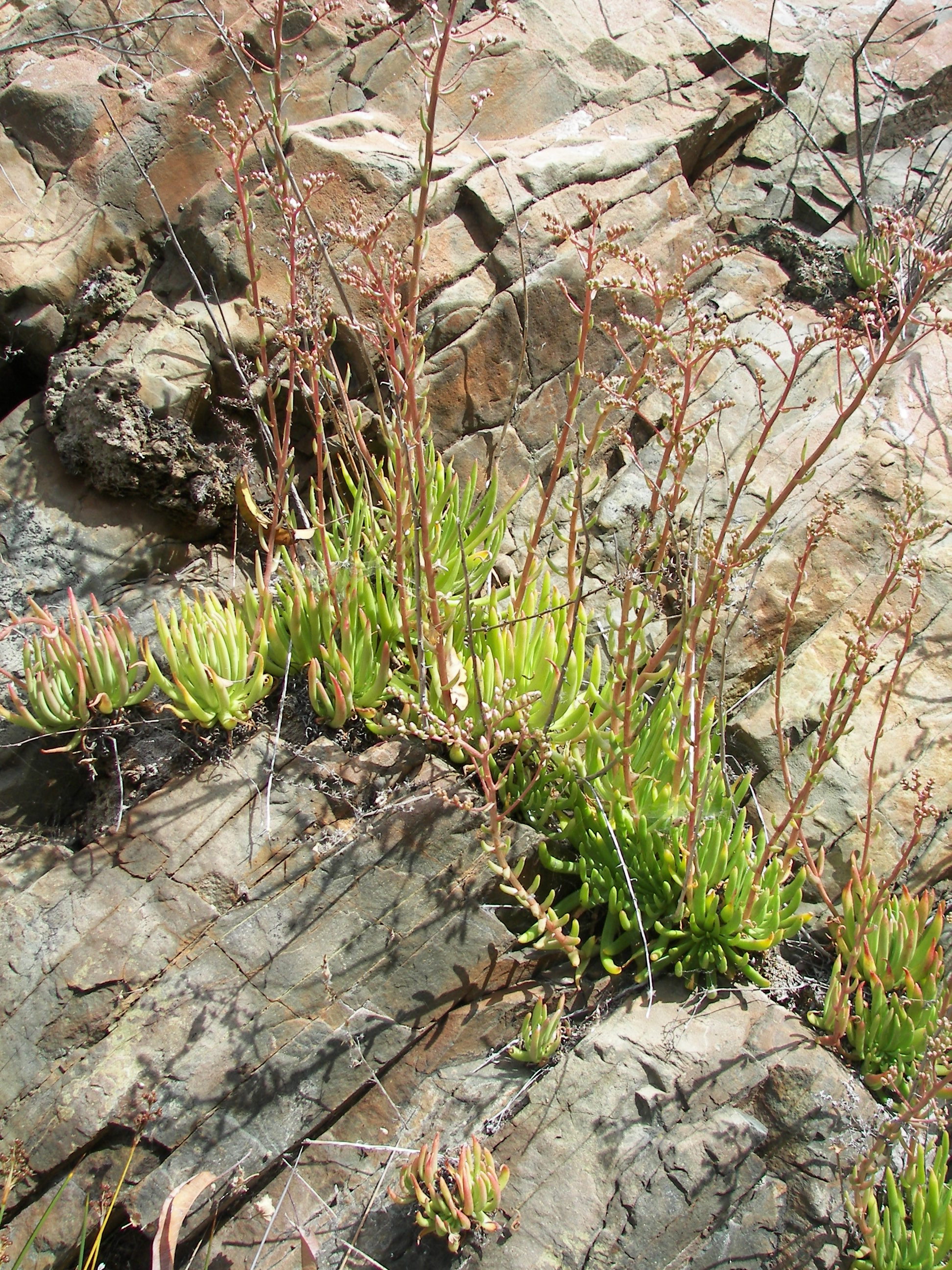
Sticky Dudleya
Dudleya viscida
Dudleya viscida
Photo Credit: Jessie Vinje
| Historically present | |
| Between 2000 and | |
| Last 10 years |
Goal: Maintain or enhance existing sticky dudleya occurrences with self sustaining populations to increase resilience to environmental and demographic stochasticity, maintain genetic diversity, and improve chances of persistence over the long term (>100 years) in chaparral and coastal sage scrub vegetation communities.
Management units: 6
In 2021, inspect sticky dudleya occurrences on Conserved Lands (see occurrence table) using the regional rare plant IMG monitoring protocol to record abundance and collect habitat and threats covariate data to determine management needs.
| Action | Statement | Action status | Projects |
|---|---|---|---|
| IMP-1 | Based upon occurrence status and threats, determine management needs including whether routine management or more intensive management is warranted. | on hold | |
| IMP-2 | Submit project metadata, monitoring datasets and management recommendations to the MSP Web Portal. | on hold |
| Criteria | Deadline year |
|---|---|
| Surveys Completed in 2021 with Management Recommendations | 2021 |
| Threat Name | Threat Code |
|---|---|
| Human uses of the Preserves | HUMUSE |
| Invasive plants | INVPLA |
Management units: 6
Beginning in 2017, conduct routine management actions as identified through the IMG monitoring conducted in 2016 and 2021 at sticky dudleya on Conserved Lands (see occurrence table). Depending on the type and level of threat, management should be conducted as needed, not necessarily every year, and using BMPs with precautions to do no harm.
| Action | Statement | Action status | Projects |
|---|---|---|---|
| IMP-1 | Perform as needed routine management activities, such as protecting occurrences from disturbance through fencing and enforcement and controlling invasive non-native plant species =20% absolute cover. | available for implementation | |
| IMP-2 | Submit project metadata and management data to the MSP Web Portal. | available for implementation |
| Criteria | Deadline year |
|---|---|
| Routine Management Completed as Needed Based Upon Monitoring Recommendations | 2021 |
| Threat Name | Threat Code |
|---|---|
| Human uses of the Preserves | HUMUSE |
| Invasive plants | INVPLA |
|
Rare Plant Inspect and Manage Monitoring 2014-2026
From 2014-2026, a Management and Monitoring Strategic Plan (MSP Roadmap) monitoring objective for 30 rare plant species is to inspect occurrences to determine management needs. The inspect and manage (IMG) objective is implemented to document the status of rare plant occurrences and assess habitats and threats to develop specific management recommendations. IMG monitoring is implemented by a combination of land managers and contracted biologists in coordination with the SDMMP. Available rare plant data is posted below. New annual updates are typically posted in March. Based upon an evaluation of these data, a 2014-2026 monitoring schedule has been developed for the 30 rare plant species (attached below). Coordinating data collection across the region allows analyses of species and population trends over time and provides a better understanding of the association between habitat and threat covariates and population dynamics.
|
| File name | Lead Author | Year | Type |
|---|---|---|---|
| Habitat Management Plan for the Rancho La Costa Habitat Conservation Area | 2005 | report | |
| Management Strategic Plan (MSP) 2015 Monitoring Protocol for Rare Plant Occurrences on Conserved Lands in Western San Diego County | San Diego Management and Monitoring Program | 2015 | report |
Endemic to southwestern California occurring in southeastern Orange, southwestern Riverside, and northwestern San Diego Counties [1]. Most occurrences are in the Santa Ana Mountains. There are 4 occurrences in MU 6[2].
None
Found on steep rocky north facing slopes in chaparral and coastal sage scrub [1]. Often found on gabbroic rock and growing in very shallow soils or from vertical rock.
In the family Crassulaceae. Dudleya is a difficult genus with much hybridization and closely related species [4]. The original base chromosome number in Crassulaceae is thought to be 8 and polyploidy has played an important role in the evolution of clades. The genus Dudleya belongs to clade Leucosedum which is widespread in the southwest United States, Mexico and Europe with most taxa having base chromosome numbers of 6 or 7. However, the meiotic chromosome number of sticky dudleya is n=17.
Herbaceous perennial [3].
looms May through June [5].
No information.
Threatened by the release of water from upstream reservoirs, trampling by hikers and climbers, and invasive plants, especially those escaped from cultivation in the urban-wildland interface [6, 7].
Sticky dudleya has been successfully translocated and seeded into cut and fill slopes above Highway 7 [6,8].
[1] Reiser, C. 1994. Rare Plants of San Diego County. http://sandiego.sierraclub.org/rareplants/ Accessed 2012 and 2013.
[2] MSP-MOM. 2013. Management Strategic Plan Master Occurrence Matrix. http://www.sdmmp.com/Home.aspx
[3] Calflora. 2013. Sticky Dudleya. www.claflora.org/
[4] Mort, M.E., D. E. Soltis, P.S. Soltis, J. Francisco-Ortega and A. Santos-Guerra. 2001. Phylogenetic relationships and evolution of Crassulaceae inferred from matK sequence data. Journal of Botany 88:76-91.
[5] Munz, P.A. 1974. A Flora of Southern California. University of California Press, Berkeley, California.
[6] Dodero, M. 2013. Personal Communication.